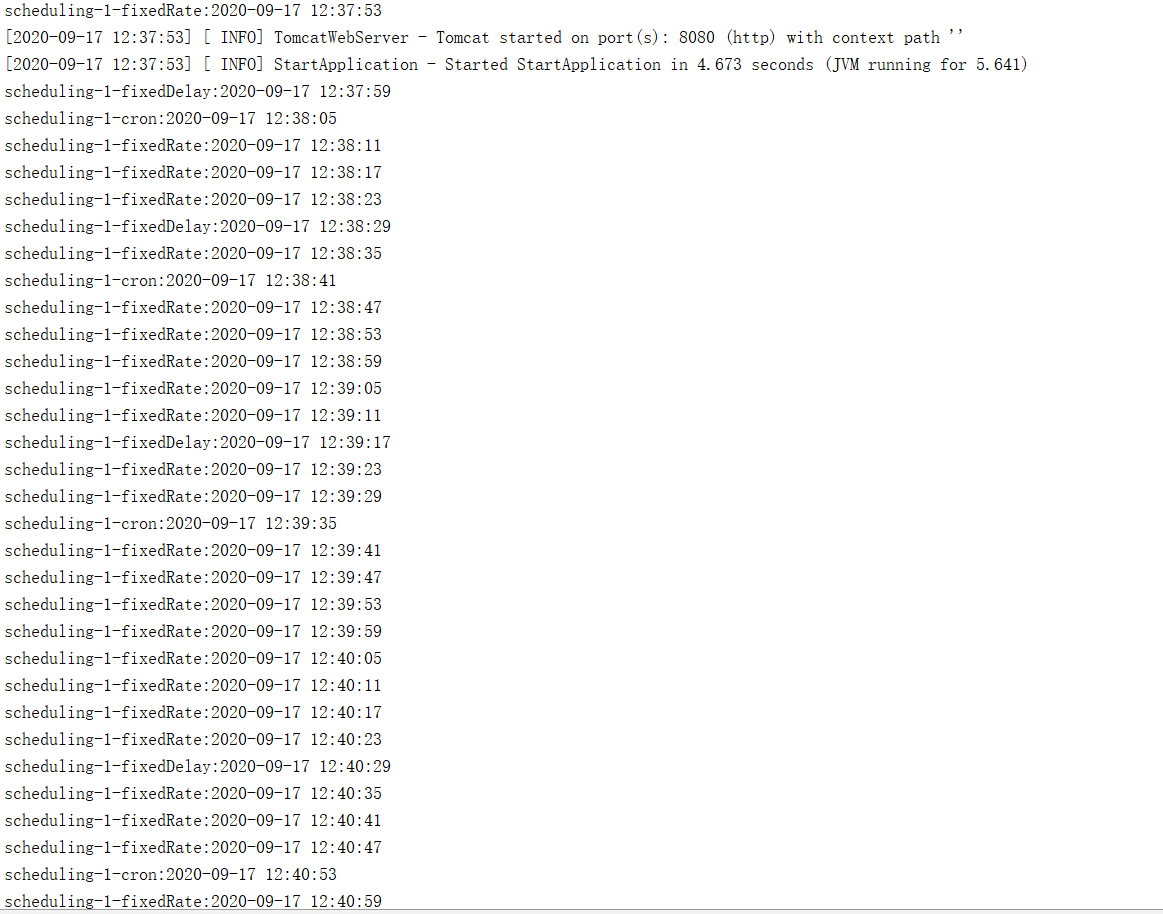您好,登錄后才能下訂單哦!
您好,登錄后才能下訂單哦!
今天就跟大家聊聊有關SpringBoot 中@Schedule的原理是什么,可能很多人都不太了解,為了讓大家更加了解,小編給大家總結了以下內容,希望大家根據這篇文章可以有所收獲。
我相信@Schedule默認線程池大小的問題肯定是被很多拿來就用的朋友忽略的問題,默認情況下@Schedule使用線程池的大小為1。
一般情況下沒有什么問題,但是如果有多個定時任務,每個定時任務執行時間可能不短的情況下,那么有的定時任務可能一直沒有機會執行。
有興趣的朋友,可以試一下:
@Component
public class BrigeTask {
private static final DateTimeFormatter FORMATTER = DateTimeFormatter.ofPattern("yyyy-MM-dd HH:mm:ss");
@Scheduled(cron = "*/5 * * * * ?")
private void cron() throws InterruptedException {
System.out.println(Thread.currentThread().getName() + "-cron:" + LocalDateTime.now().format(FORMATTER));
TimeUnit.SECONDS.sleep(6);
}
@Scheduled(fixedDelay = 5000)
private void fixedDelay() throws InterruptedException {
System.out.println(Thread.currentThread().getName() + "-fixedDelay:" + LocalDateTime.now().format(FORMATTER));
TimeUnit.SECONDS.sleep(6);
}
@Scheduled(fixedRate = 5000)
private void fixedRate() throws InterruptedException {
System.out.println(Thread.currentThread().getName() + "-fixedRate:" + LocalDateTime.now().format(FORMATTER));
TimeUnit.SECONDS.sleep(6);
}
}上面的任務中,fixedDelay與cron,可能很久都不會被執行。

要解決上面的問題,可以把執行任務的線程池設置大一點,怎樣設置通過實現SchedulingConfigurer接口,在configureTasks方法中配置,這種方式參見后面的代碼,這里可以直接注入一個TaskScheduler來解決問題。
@Bean
public TaskScheduler taskScheduler() {
ThreadPoolTaskScheduler taskScheduler = new ThreadPoolTaskScheduler();
taskScheduler.setPoolSize(5);
return taskScheduler;
}當然也可以使用ScheduledExecutorService:
@Bean
public ScheduledExecutorService scheduledExecutorService() {
return Executors.newScheduledThreadPool(10);
}為啥這樣有效,請參考后面@Schedule原理。
@Schedule的三種方式cron、fixedDelay、fixedRate不管線程夠不夠都會阻塞到上一次執行完成,才會執行下一次。
如果任務方法執行時間非常短,上面三種方式其實基本沒有太多的區別。
如果,任務方法執行時間比較長,大于了設置的執行周期,那么就有很大的區別。例如,假設執行任務的線程足夠,執行周期是5s,任務方法會執行6s。
cron的執行方式是,任務方法執行完,遇到下一次匹配的時間再次執行,基本就會10s執行一次,因為執行任務方法的時間區間會錯過一次匹配。
fixedDelay的執行方式是,方法執行了6s,然后會再等5s再執行下一次,在上面的條件下,基本就是每11s執行一次。
fixedRate的執行方式就變成了每隔6s執行一次,因為按固定區間執行它沒5s就應該執行一次,但是任務方法執行了6s,沒辦法,只好6s執行一次。
上面的結論都可以通過,最上面的示例驗證,有興趣的朋友可以調整一下休眠時間測試一下。
在SpringBoot中,我們使用@EnableScheduling來啟用@Schedule。
@Target(ElementType.TYPE)
@Retention(RetentionPolicy.RUNTIME)
@Import(SchedulingConfiguration.class)
@Documented
public @interface EnableScheduling {
}EnableScheduling注解沒什么特殊,需要注意import了SchedulingConfiguration。
SchedulingConfiguration一看名字就知道是一個配置類,肯定是為了添加相應的依賴類。
@Configuration
@Role(BeanDefinition.ROLE_INFRASTRUCTURE)
public class SchedulingConfiguration {
@Bean(name = TaskManagementConfigUtils.SCHEDULED_ANNOTATION_PROCESSOR_BEAN_NAME)
@Role(BeanDefinition.ROLE_INFRASTRUCTURE)
public ScheduledAnnotationBeanPostProcessor scheduledAnnotationProcessor() {
return new ScheduledAnnotationBeanPostProcessor();
}
}我們可以看到在SchedulingConfiguration創建了一個ScheduledAnnotationBeanPostProcessor。
看樣子SpringBoot定時任務的核心就是ScheduledAnnotationBeanPostProcessor類了,下面我們來看一看ScheduledAnnotationBeanPostProcessor類。
public class ScheduledAnnotationBeanPostProcessor
implements ScheduledTaskHolder, MergedBeanDefinitionPostProcessor, DestructionAwareBeanPostProcessor,
Ordered, EmbeddedValueResolverAware, BeanNameAware, BeanFactoryAware, ApplicationContextAware,
SmartInitializingSingleton, ApplicationListener<ContextRefreshedEvent>, DisposableBean {
}ScheduledAnnotationBeanPostProcessor實現了很多接口,這里重點關注2個,ApplicationListener和DestructionAwareBeanPostProcessor。
DestructionAwareBeanPostProcessor繼承了BeanPostProcessor。
BeanPostProcessor相信大家已經非常熟悉了,就是在Bean創建執行setter之后,在自定義的afterPropertiesSet和init-method前后提供攔截點,大致執行的先后順序是:
Bean實例化 -> setter -> BeanPostProcessor#postProcessBeforeInitialization ->
-> InitializingBean#afterPropertiesSet -> init-method -> BeanPostProcessor#postProcessAfterInitialization
我們看一下ScheduledAnnotationBeanPostProcessor的postProcessAfterInitialization方法:
@Override
public Object postProcessAfterInitialization(Object bean, String beanName) {
if (bean instanceof AopInfrastructureBean || bean instanceof TaskScheduler ||
bean instanceof ScheduledExecutorService) {
// Ignore AOP infrastructure such as scoped proxies.
return bean;
}
Class<?> targetClass = AopProxyUtils.ultimateTargetClass(bean);
if (!this.nonAnnotatedClasses.contains(targetClass) &&
AnnotationUtils.isCandidateClass(targetClass, Arrays.asList(Scheduled.class, Schedules.class))) {
Map<Method, Set<Scheduled>> annotatedMethods = MethodIntrospector.selectMethods(targetClass,
(MethodIntrospector.MetadataLookup<Set<Scheduled>>) method -> {
Set<Scheduled> scheduledMethods = AnnotatedElementUtils.getMergedRepeatableAnnotations(
method, Scheduled.class, Schedules.class);
return (!scheduledMethods.isEmpty() ? scheduledMethods : null);
});
if (annotatedMethods.isEmpty()) {
this.nonAnnotatedClasses.add(targetClass);
if (logger.isTraceEnabled()) {
logger.trace("No @Scheduled annotations found on bean class: " + targetClass);
}
}
else {
// Non-empty set of methods
annotatedMethods.forEach((method, scheduledMethods) ->
scheduledMethods.forEach(scheduled -> processScheduled(scheduled, method, bean)));
if (logger.isTraceEnabled()) {
logger.trace(annotatedMethods.size() + " @Scheduled methods processed on bean '" + beanName +
"': " + annotatedMethods);
}
}
}
return bean;
}簡單說一下流程:
找到所有的Schedule方法,把它封裝為ScheduledMethodRunnable類(ScheduledMethodRunnable類實現了Runnable接口),并把其做為一個任務注冊到ScheduledTaskRegistrar中。
如果對具體的邏輯感興趣,可以從postProcessAfterInitialization方法順著processScheduled方法一次debug。
前面我們介紹通過BeanPostProcessor解析出了所有的任務,接下來要做的事情就是提交任務了。
@Override
public void onApplicationEvent(ContextRefreshedEvent event) {
if (event.getApplicationContext() == this.applicationContext) {
// Running in an ApplicationContext -> register tasks this late...
// giving other ContextRefreshedEvent listeners a chance to perform
// their work at the same time (e.g. Spring Batch's job registration).
finishRegistration();
}
}ScheduledAnnotationBeanPostProcessor監聽的事件是ContextRefreshedEvent,就是在容器初始化,或者刷新的時候被調用。
監聽到ContextRefreshedEvent事件之后,值調用了finishRegistration方法,這個方法的基本流程如下:
找到容器中的SchedulingConfigurer,并調用它的configureTasks,SchedulingConfigurer的作用主要就是配置ScheduledTaskRegistrar類,例如線程池等參數,例如:
import org.springframework.context.annotation.Configuration;
import org.springframework.scheduling.annotation.SchedulingConfigurer;
import org.springframework.scheduling.config.ScheduledTaskRegistrar;
import java.util.concurrent.Executors;
@Configuration
public class MyScheduleConfig implements SchedulingConfigurer {
@Override
public void configureTasks(ScheduledTaskRegistrar taskRegistrar) {
taskRegistrar.setScheduler(Executors.newScheduledThreadPool(10));
}
}調用ScheduledTaskRegistrar的afterPropertiesSet方法執行任務,如果對具體的邏輯感興趣,可以閱讀ScheduledTaskRegistrar的scheduleTasks方法。
看完上述內容,你們對SpringBoot 中@Schedule的原理是什么有進一步的了解嗎?如果還想了解更多知識或者相關內容,請關注億速云行業資訊頻道,感謝大家的支持。
免責聲明:本站發布的內容(圖片、視頻和文字)以原創、轉載和分享為主,文章觀點不代表本網站立場,如果涉及侵權請聯系站長郵箱:is@yisu.com進行舉報,并提供相關證據,一經查實,將立刻刪除涉嫌侵權內容。